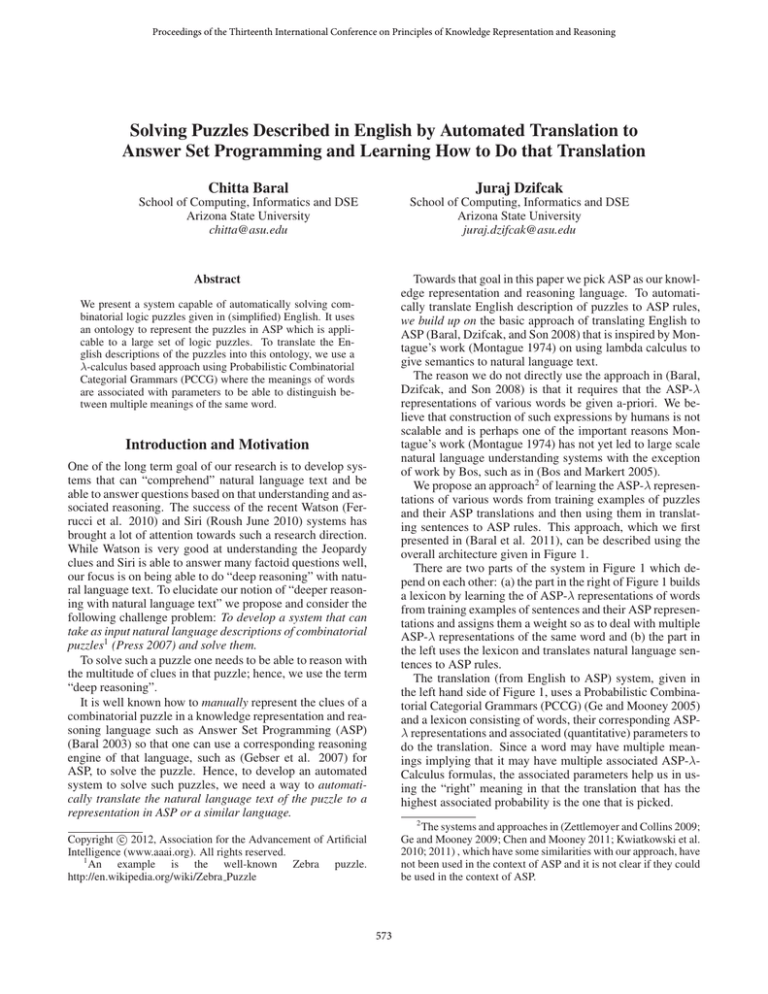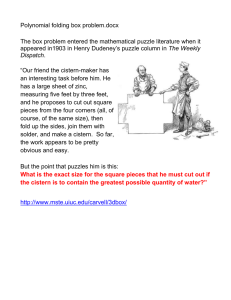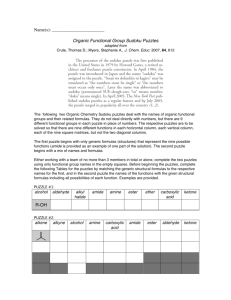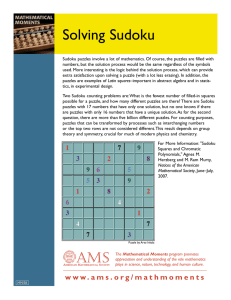
Proceedings of the Thirteenth International Conference on Principles of Knowledge Representation and Reasoning
Solving Puzzles Described in English by Automated Translation to
Answer Set Programming and Learning How to Do that Translation
Chitta Baral
Juraj Dzifcak
School of Computing, Informatics and DSE
Arizona State University
chitta@asu.edu
School of Computing, Informatics and DSE
Arizona State University
juraj.dzifcak@asu.edu
Abstract
Towards that goal in this paper we pick ASP as our knowledge representation and reasoning language. To automatically translate English description of puzzles to ASP rules,
we build up on the basic approach of translating English to
ASP (Baral, Dzifcak, and Son 2008) that is inspired by Montague’s work (Montague 1974) on using lambda calculus to
give semantics to natural language text.
The reason we do not directly use the approach in (Baral,
Dzifcak, and Son 2008) is that it requires that the ASP-λ
representations of various words be given a-priori. We believe that construction of such expressions by humans is not
scalable and is perhaps one of the important reasons Montague’s work (Montague 1974) has not yet led to large scale
natural language understanding systems with the exception
of work by Bos, such as in (Bos and Markert 2005).
We propose an approach2 of learning the ASP-λ representations of various words from training examples of puzzles
and their ASP translations and then using them in translating sentences to ASP rules. This approach, which we first
presented in (Baral et al. 2011), can be described using the
overall architecture given in Figure 1.
There are two parts of the system in Figure 1 which depend on each other: (a) the part in the right of Figure 1 builds
a lexicon by learning the of ASP-λ representations of words
from training examples of sentences and their ASP representations and assigns them a weight so as to deal with multiple
ASP-λ representations of the same word and (b) the part in
the left uses the lexicon and translates natural language sentences to ASP rules.
The translation (from English to ASP) system, given in
the left hand side of Figure 1, uses a Probabilistic Combinatorial Categorial Grammars (PCCG) (Ge and Mooney 2005)
and a lexicon consisting of words, their corresponding ASPλ representations and associated (quantitative) parameters to
do the translation. Since a word may have multiple meanings implying that it may have multiple associated ASP-λCalculus formulas, the associated parameters help us in using the “right” meaning in that the translation that has the
highest associated probability is the one that is picked.
We present a system capable of automatically solving combinatorial logic puzzles given in (simplified) English. It uses
an ontology to represent the puzzles in ASP which is applicable to a large set of logic puzzles. To translate the English descriptions of the puzzles into this ontology, we use a
λ-calculus based approach using Probabilistic Combinatorial
Categorial Grammars (PCCG) where the meanings of words
are associated with parameters to be able to distinguish between multiple meanings of the same word.
Introduction and Motivation
One of the long term goal of our research is to develop systems that can “comprehend” natural language text and be
able to answer questions based on that understanding and associated reasoning. The success of the recent Watson (Ferrucci et al. 2010) and Siri (Roush June 2010) systems has
brought a lot of attention towards such a research direction.
While Watson is very good at understanding the Jeopardy
clues and Siri is able to answer many factoid questions well,
our focus is on being able to do “deep reasoning” with natural language text. To elucidate our notion of “deeper reasoning with natural language text” we propose and consider the
following challenge problem: To develop a system that can
take as input natural language descriptions of combinatorial
puzzles1 (Press 2007) and solve them.
To solve such a puzzle one needs to be able to reason with
the multitude of clues in that puzzle; hence, we use the term
“deep reasoning”.
It is well known how to manually represent the clues of a
combinatorial puzzle in a knowledge representation and reasoning language such as Answer Set Programming (ASP)
(Baral 2003) so that one can use a corresponding reasoning
engine of that language, such as (Gebser et al. 2007) for
ASP, to solve the puzzle. Hence, to develop an automated
system to solve such puzzles, we need a way to automatically translate the natural language text of the puzzle to a
representation in ASP or a similar language.
2
The systems and approaches in (Zettlemoyer and Collins 2009;
Ge and Mooney 2009; Chen and Mooney 2011; Kwiatkowski et al.
2010; 2011) , which have some similarities with our approach, have
not been used in the context of ASP and it is not clear if they could
be used in the context of ASP.
c 2012, Association for the Advancement of Artificial
Copyright Intelligence (www.aaai.org). All rights reserved.
1
An example is the well-known Zebra puzzle.
http://en.wikipedia.org/wiki/Zebra Puzzle
573
a human preprocessing6 of puzzles to eliminate anaphora
and features that may lead to a sentence being translated
into multiple ASP rules. Besides translating the given English sentences, we added some domain knowledge related
to combinatorial logic puzzles. This is in line with the fact
that often natural language understanding involves going beyond literal understanding of a given text and taking into
context some background knowledge. We adopted a standard “Generate and test” approach in solving the puzzles.
The domain of the puzzle is used to generate all the possible solutions of the puzzle, which are then tested against the
constraints obtained from the clues by translating them into
ASP representation using our system that learns how to do
such translations.
The learning system takes a given training set of sentences and their corresponding ASP-λ-Calculus rules, and
an initial vocabulary (consisting of some words and their
meaning) and uses Inverse λ algorithms3 and Generalization4 techniques to obtain the meaning of words which are
encountered but are not in the initial lexicon. Because of the
generalization step and because of the inherent ambiguity
of words having multiple meanings, one may end up with
a lexicon where words are associated with multiple ASPλ-Calculus rules. A parameter learning method is used to
assign weights to each meaning of a word in such a way that
the probability that each sentence in the training set would
be translated to the given corresponding ASP-λ-Calculus
rule (using the approach in the left hand side of Figure 1)
is maximized. The block diagram of this learning system is
given in the right hand side of Figure 1.
A key aspect in being able to use the above approach is to
have an ontology of the puzzle representation that will allow
one to learn more general representation from given puzzle
encoding examples, and use it in new puzzle. In this regards,
we noticed that although there are many examples of puzzle
encodings in ASP, they were not amenable to be useful in
a learning based system where the system learns representations of words from given examples of puzzles and their
ASP code and then uses that to translate other puzzles. Considering that in our case the translation of English description of the puzzles into ASP is to be done by an automated
system and this system learns aspects of the translation by
going over a training set, we need to develop an ontology
of representing puzzles in ASP that is applicable to most
(if not all) combinatorial logic puzzles. This is one of the
main contributions of the paper. Some of the other contributions of this paper are: We developed an overall system
that learns to solve combinatorial puzzles in English under
certain assumptions. We developed a system that learns to
translate simplified5 English to ASP. We developed a small
initial lexicon of words and their ASP-λ representations that
allows us to learn the representations of other words in puzzles and solve new puzzles using them. We identified some
of the background knowledge that is needed to be added to
the system.
Puzzle representation and Ontology
For our experiments, we focus on logic puzzles from (Press
2007; 2004; Dell 2005). These logic puzzles have a set of
basic domain data and a set of clues.
For example, a puzzle may have the domain data: 1,2,3,4
and 5 are ranks; earl, ivana, lucy, philip and tony are names;
earth, fire, metal, water and wood are elements; and cow,
dragon, horse, ox and rooster are animals.
Such domain data is encoded using the following format,
where etype(A, t) stores the element type t under the index
A, while element(A, X) is the predicate storing all the elements X of the type etype(A, type) under the index A. An
example of an instance of this encoding is given below.
index(1..n).
% size of a tuple
eindex(1..m). % number of tuples
% type and lists of elements of that type,
% one element from each index forms a tuple
etype(1, type1).
element(1, el11). element(1, el12). ...
element(1, el1n).
...
For the given puzzle, the encoding would look like:
index(1..4).
eindex(1..5).
etype(1, name).
element(1,earl). element(1,ivana).
element(1,lucy). element(1,philip).
element(1,tony).
etype(2, element).
element(2,earth). element(2,fire).
element(2,metal). element(2,water).
element(2,wood). ...
Assumptions and Background Knowledge
With our longer term goal to be able to solve combinatorial
logic puzzles specified in English, as mentioned earlier, we
made some simplifying assumptions for this current work.
Here we assumed that the domains of puzzles are given (and
one does not have to extract them from the puzzle description) and focused on accurately translating the clues. We did
In addition, to avoid permutations among the tuples, the
following facts are generated, where tuple(I, X) is the
predicate storing the elements X within a tuple I:
3
They compute an expression F given ASP-λ-calculus expressions G and H such that F@G or = H or G@F = H.
4
This includes modifying a known ASP-λ-calculus expression
for other words of the same category(Baral et al. 2011).
5
Our simplified English is different from “controlled” English
in that it does not have a pre-specified grammar. We only do some
preprocessing to eliminate anaphora and some other aspects.
tuple(1,e11). ... tuple(1,e1n).
Using the above ontology clues are expressed as follows:
6
The people doing the pre-processing were not told of any specific subset of English or any “Controlled” English to use. They
were only asked to simplify the sentences so that each sentence
would translate to a single clue.
574
Figure 1: Overall system architecture
Extracting relevant facts from the puzzle clues
%Tony was the third person to have
%his fortune told.
:- tuple(I, tony), not tuple(I, 3).
A sample of clues with their corresponding representations
was given earlier. Let us take a closer look at the clue “Tony
was the third person to have his fortune told.”, encoded as
:- tuple(I, tony), not tuple(I, 3). This encoding specifies
that if “Tony” is assigned to tuple I, while the rank “3” is
not assigned to the tuple I, we obtain False. Thus this ASP
rule limits all the models of it’s program to have “Tony”
assigned to the same tuple as “3”. One of the questions
one might ask is where are the semantic data for “person”
or “fortune told”. They are missing from the translation
since with respect to the actual goal of solving the puzzle,
they do not contribute anything new or relevant. The fact
that “Tony” is a “person” is not relevant. With this encoding, we attempt to encode only new and relevant information with regards to the solutions of the puzzle. This is to
keep the structure of the encodings as simple and as general as possible. In addition, if the rule would be encoded as
:- person(tony), tuple(I, tony), not tuple(I, 3)., the fact
person(tony) would have to be added to the program in order for the constraint to give it’s desired meaning. However,
this does not seem reasonable as there is no apparent reason to add it (outside for the clue to actually work), since
“person” is not part of the domain data of the puzzle.
%The person with the Lucky Element
%Wood had their fortune told fifth.
:- tuple(I, wood), not tuple(I, 5).
%Earl’s lucky element is Fire.
:- tuple(I, earl), not tuple(I, fire).
%Earl arrived immediately before
%the person with the Rooster.
:- tuple(I, earl), tuple(J, rooster),
tuple(I, X), tuple(J, Y),
etype(A, rank), element(A, X),
element(A, Y), X != Y-1.
Generic modules and background knowledge
Given the puzzle domain data, we combine their encodings with additional modules responsible for generation and
background knowledge. The following rules are responsible
for generation of all the possible tuples, where we assume
that all the elements are exclusive.
1{tuple(I,X):element(A,X)}1.
:- tuple(I,X), tuple(J,X),
element(K,X), I != J.
Translating Natural language to ASP
In addition,
a module with rules defining
generic/background knowledge is used so as to provide higher level knowledge which the clues define. For
example, a clue might discuss maximum, minimum, or
genders such as woman. Thus rules defining concepts and
knowledge such as maximum (max), minimum, within
range, sister is a woman and others are added. For example,
the concept “max” is encoded as:
To translate the English descriptions into ASP, we adopt
the approach in (Baral et al. 2011). This approach uses
Inverse-λ computations and generalization techniques together with learning. However for this paper, we had to
adapt the approach to the ASP language and develop an
ASP-λ-Calculus. An example of a clue translation using combinatorial categorial grammar (Steedman 2000) and
ASP-λ-calculus is given in table 1.
notmax(A, X) :- element(A, X),
element(A, Y), etype(A,numerical),
X != Y, Y > X.
max(A, X) :- not notmax(A,X),
element(A,X),
etype(A,numerical).
The overall learning algorithm
The input to the overall learning algorithm is a set of pairs
(Si , Li ), i = 1, ..., n, where Si is a sentence and Li its corresponding logical form. The output of the algorithm is a
PCCG defined by the lexicon LT and a parameter vector
575
ΘT . As given by (Baral et al. 2011), the parameter vector
Θi is updated at each iteration of the algorithm. It stores
a real number for each item in the dictionary. The overall
learning algorithm is given as follows:
data. The C&C parser (Clark and Curran 2007) was used to
obtain the majority of the syntactic categories. The background knowledge for the 50 puzzles contained 62 different
ASP facts and rules, with the puzzles having 17.6 clues on
average (880 total).
• Input: A set of training sentences with their corresponding desired representations S = {(Si , Li ) : i = 1...n} where Si are
sentences and Li are desired expressions. Weights are given an
initial value of 0.1.
An initial feature vector Θ0 . An initial lexicon L0 .
Results
The results are given in tables 2 and 3. The “10-fold” corresponds to experiments with 10-fold cross validation, “10-s”,
“15-s” and “20-s” corresponds to experiments where 10, 15
and 20 puzzles were manually chosen as training data respectively.
• Output: An updated lexicon LT +1 . An updated feature vector
ΘT +1 .
• Algorithm:
Precision
87.13
Set L0
For t = 1 . . . T
Step 1: (Lexical generation)
For i = 1...n.
∗ For j = 1...n.
∗ Parse sentence Sj to obtain Tj
∗ Traverse Tj
· apply
IN V ERSE L,
IN V ERSE R
and
GEN ERALIZED to find new ASP-λ-calculus
expressions of words and phrases α.
∗ Set Lt+1 = Lt ∪ α
– Step 2: (Parameter Estimation)
– Set Θt+1 = U P DAT E(Θt , Lt+1 )
–
–
–
–
Recall
85.86
F-measure
86.49
Table 2: Clue translation performance.
10-Fold
10-s
15-s
20-s
Accuracy
27/50 (54%)
21/40 (52.5%)
23/35 (65.71%)
25/30 (83.33%)
Table 3: Performance on puzzle solving.
The results for clue translation to ASP are comparable
to translating natural language sentences to Geoquery and
Robocup domains in (Baral et al. 2011), and used in similar
works such as (Zettlemoyer and Collins 2007) and (Ge and
Mooney 2009). Our results are close to the values reported
there, which range from 88 to 92 percent for the database
domain and 75 to 82 percent for the Robocup domain.
• return GEN ERALIZE(LT , LT ), Θ(T )
To translate the clues, a trained model was used to translate these from natural language into ASP. This model includes a dictionary with ASP-λ-calculus formulas corresponding to the semantic representations of words. These
have their corresponding weights.
Conclusion and Future work
In this paper we presented a learning based approach to solve
combinatorial logic puzzles in English. Our system uses an
initial dictionary and sample puzzles in simplified English
and their ASP representations to learn how to translate new
puzzles (given in simplified English) to ASP and solve them,
where the unique answer set of the translated ASP program
corresponds to the solution of the puzzle. In the process it
may use some general knowledge modules. Our system used
results and components from various AI sub-disciplines including natural language processing, knowledge representation and reasoning, machine learning and ontologies as well
as the functional programming concept of λ-calculus. There
are many ways to extend our work. The simplified English
limitation might be lifted by better natural language processing tools and additional sentence analysis. We could also apply our approach to different types of puzzles. A modified
encodings might yield a smaller variance in the results. Finally we would like to submit that solving puzzles given in a
natural language could be considered as a challenge problem
for human level intelligence as it encompasses various facets
of intelligence that we listed earlier. In particular, one has to
use a reasoning system and can not substitute it with surface level analysis that is often used in information retrieval
based methods.
For future work, we would like to add additional background knowledge which can be found in different puzzles.
Evaluation
To evaluate the clue translation, we manually selected
800 clues. Standard 10 fold cross validation was used.
P recision measures the number of correctly translated
clues, save for permutations in the body of the rules, or head
of disjunctive rules. Recall measures the number of correct exact translations, F -measure is the harmonic mean of
Recall and Precision.
To evaluate the puzzles, we used the following approach.
A number of puzzles were selected and all their clues
formed the training data for the natural language module.
The training data was used to learn the meaning of words
and the associated parameters and these were then used to
translate the English clues to ASP. These were then combined with the corresponding puzzle domain data, and the
generic/background ASP module. The resulting program
was solved using clingo, an extension of clasp (Gebser et
al. 2007). Accuracy measured the number of correctly
solved puzzles. A puzzle was considered correctly solved
if it provided a single correct solution. If a rule provided by
the clue translation from English into ASP was not syntactically correct, it was discarded. We did several experiments.
Using the 50 puzzles, we did a 10-fold cross validation to
measure the accuracy. In addition, we did additional experiments with 10, 15 and 20 puzzle manually chosen as training
576
Earl’s
N P/N P
N P/N P
NP
NP
Earl’s
λx.(x@earl)
λx.(x@earl)
earl
earl
lucky
λx.x
λx.x
lucky
N P/N P
NP
element
λx.x
element
NP
is
fire.
(S\N P )/N P N P
(S\N P )/N P N P
(S\N P )
(S\N P )
S
is
λx.λy. : −tuple(I, x), not tuple(I, y).
λx.λy. : −tuple(I, x), not tuple(I, y).
λx. : −tuple(I, x), not tuple(I, f ire).
λx. : −tuple(I, x), not tuple(I, f ire).
: −tuple(I, earl), not tuple(I, f ire).
fire.
f ire
f ire
Table 1: CCG and λ-calculus derivation for “Earl’s lucky element is fire.”
Clark, S., and Curran, J. R. 2007. Wide-coverage efficient
statistical parsing with ccg and log-linear models. Computational Linguistics 33.
Dell. 2005. Logic puzzles.
Ferrucci, D. A.; Brown, E. W.; Chu-Carroll, J.; Fan, J.;
Gondek, D.; Kalyanpur, A.; Lally, A.; Murdock, J. W.; Nyberg, E.; Prager, J. M.; Schlaefer, N.; and Welty, C. A. 2010.
Building watson: An overview of the deepqa project. AI
Magazine 31(3):59–79.
Ge, R., and Mooney, R. J. 2005. A statistical semantic
parser that integrates syntax and semantics. In Proceedings
of CoNLL., 9–16.
Ge, R., and Mooney, R. J. 2009. Learning a compositional
semantic parser using an existing syntactic parser. In Proceedings of ACL-IJCNLP., 611–619.
Gebser, M.; Kaufmann, B.; Neumann, A.; and Schaub, T.
2007. Clasp : A conflict-driven answer set solver. In LPNMR, 260–265.
Kwiatkowski, T.; Zettlemoyer, L.; Goldwater, S.; and Steedman, M. 2010. Inducing probabilistic ccg grammars from
logical form with higher-order unification. In the 2010
Conf. on Empirical Methods in Natural Language Processing (EMNLP), 1223–1233.
Kwiatkowski, T.; Zettlemoyer, L. S.; Goldwater, S.; and
Steedman, M. 2011. Lexical generalization in ccg grammar
induction for semantic parsing. In EMNLP, 1512–1523.
Montague, R. 1974. Formal Philosophy. Selected Papers of
Richard Montague. Yale University Press.
Press, P. 2004. Logic problems.
Press, P. 2007. England’s best logic problems.
Roush, W. June 2010. The story of siri, from birth at
sri to acquisition by apple: Virtual personal assistants
go mobile.
Xconomy; http://www.xconomy. com/sanfrancisco/2010/06/14/the-story-of-sirifrom-birth-at-sri-toacquisition-by-apple-virtualpersonal-assistants-go-mobile/.
Steedman, M. 2000. The syntactic process. MIT Press.
Zettlemoyer, L., and Collins, M. 2007. Online learning of
relaxed ccg grammars for parsing to logical form. In Proceedings of EMNLP-CoNLL, 678–687.
Zettlemoyer, L., and Collins, M. 2009. Learning contextdependent mappings from sentences to logical form. In ACL.
Our current modules only covered the puzzles we used for
evaluation, however many new puzzles may require different background knowledge. For example, geographical information or locations of world cities are required in order
to solve some of the other puzzles. In this work, we assumed
that the domain of the puzzle is given for each puzzle. However, it might be possible to extract this information from
the actual clues and the puzzle’s accompanying story. Such
system would then be able to automatically generate the domain of a puzzle, while the presented system can be used
to translate the clues. Another limitation of the presented
work is that the clues had to be manually pre-processed by
humans to get rid of anaphoras. This can be avoided by programs that can preprocess anaphora and can split the clues
in a such a way that the presented system can learn from
them. With such improvements in place, the system could
be made fully automatic. It could then just be given a set of
puzzles with ASP solutions, and it would learn from it and
then be able to solve new puzzles without any human intervention. That is our goal and we propose it as a challenge
to the community.
Acknowledgement
We acknowledge support by NSF (grant number 0950440),
IARPA and ONR-MURI for this work.
References
Baral, C.; Gonzalez, M.; Dzifcak, J.; and Zhou, J. 2011.
Using inverse λ and generalization to translate english to
formal languages. In Proceedings of the International Conference on Computational Semantics, Oxford, England, January 2011. http://arxiv.org/abs/1108.3843.
Baral, C.; Dzifcak, J.; and Son, T. C. 2008. Using ASP and
lambda calculus to characterize NL sentences with normatives and exceptions. In AAAI, 818–823.
Baral, C. 2003. Knowledge Representation, Reasoning, and
Declarative Problem Solving. Cambridge University Press.
Bos, J., and Markert, K. 2005. Recognising textual entailment with logical inference. In HLT/EMNLP.
Chen, D. L., and Mooney, R. J. 2011. Learning to interpret
natural language navigation instructions from observations.
In AAAI.
577




